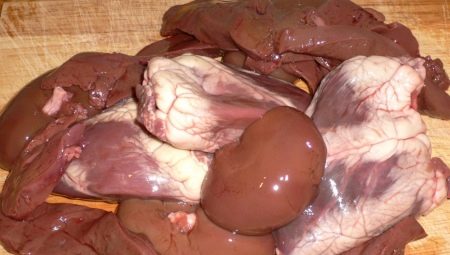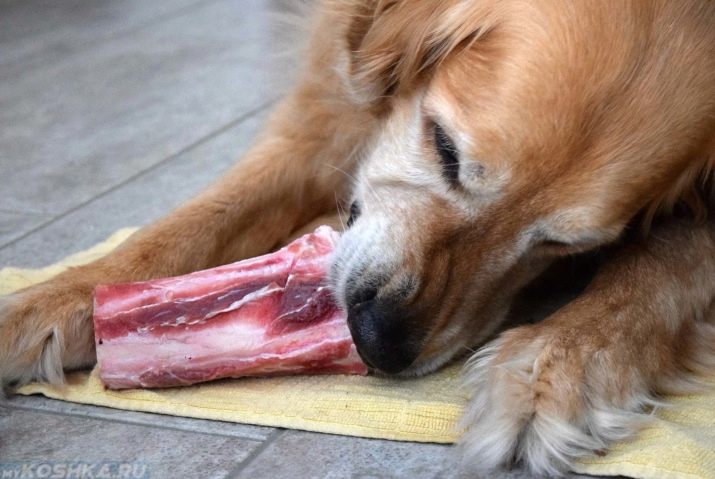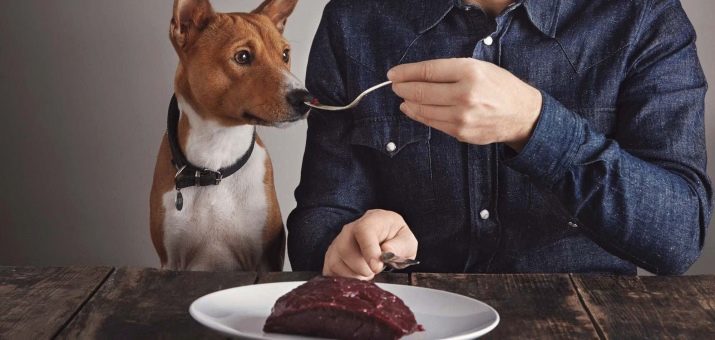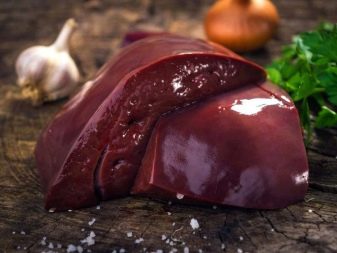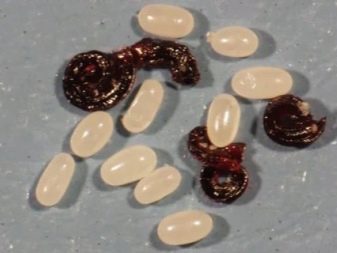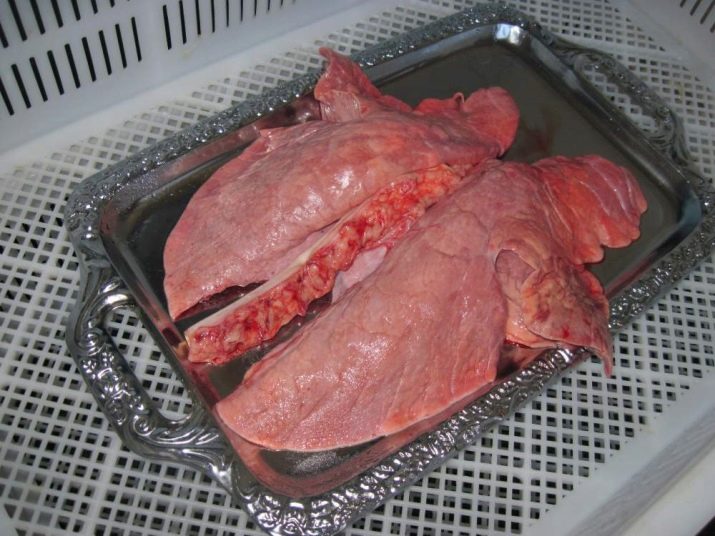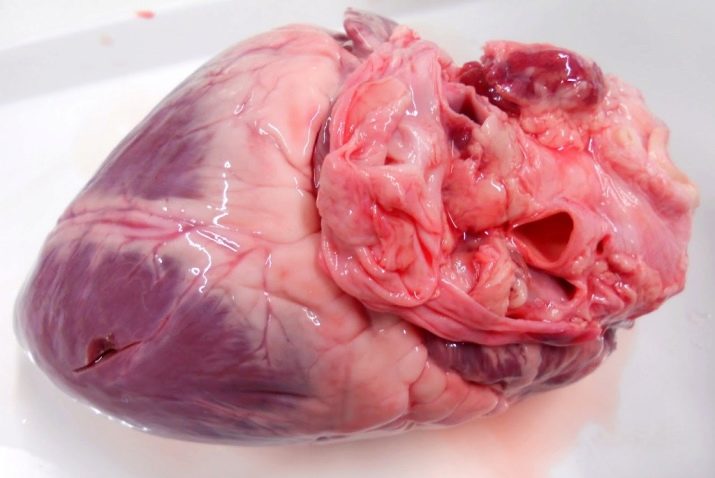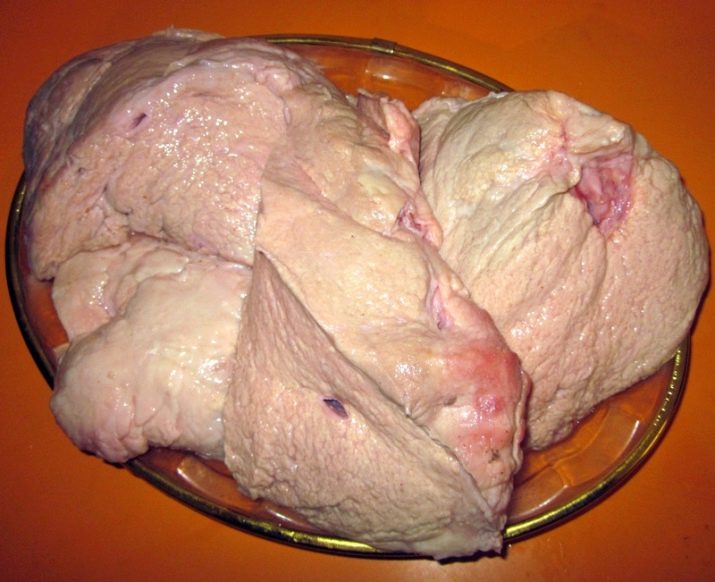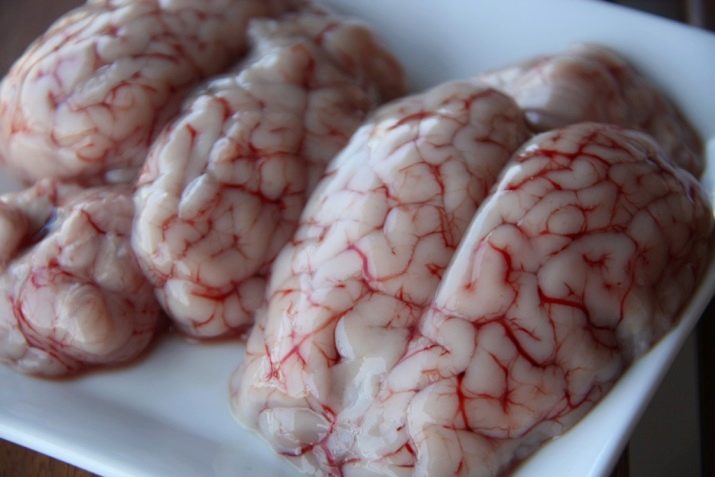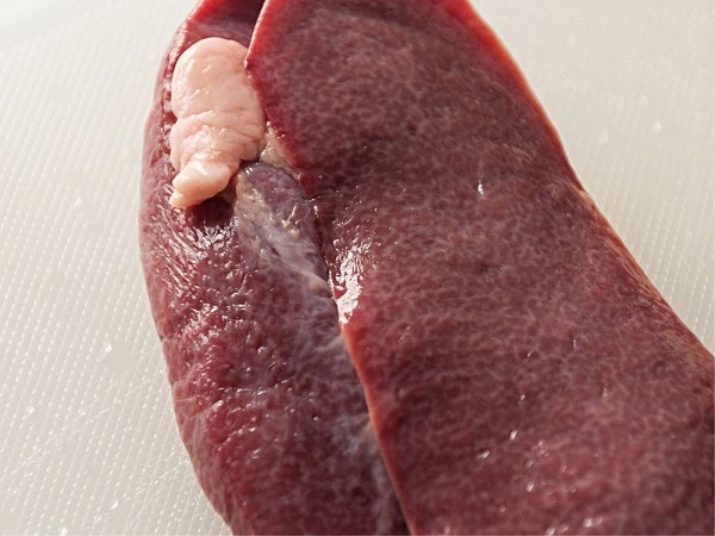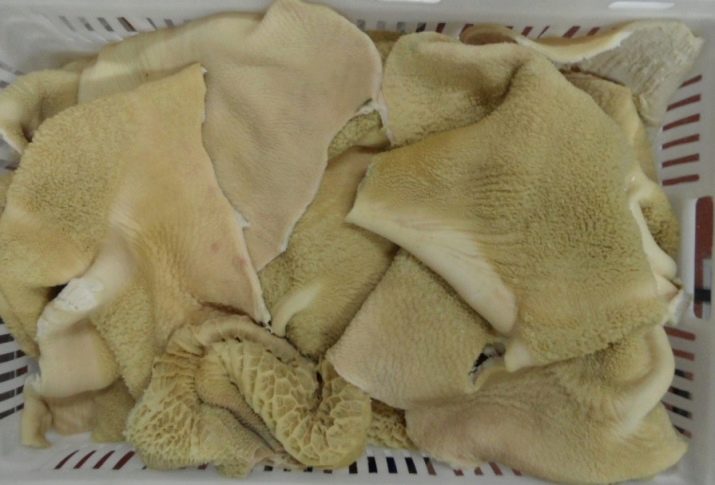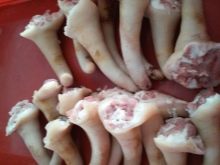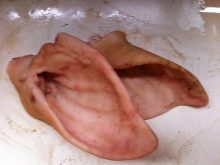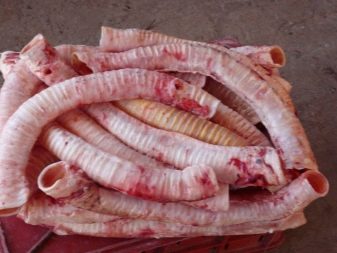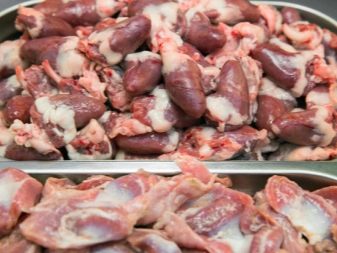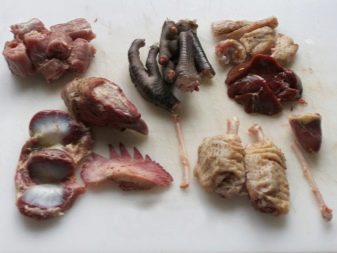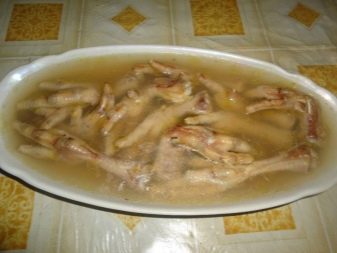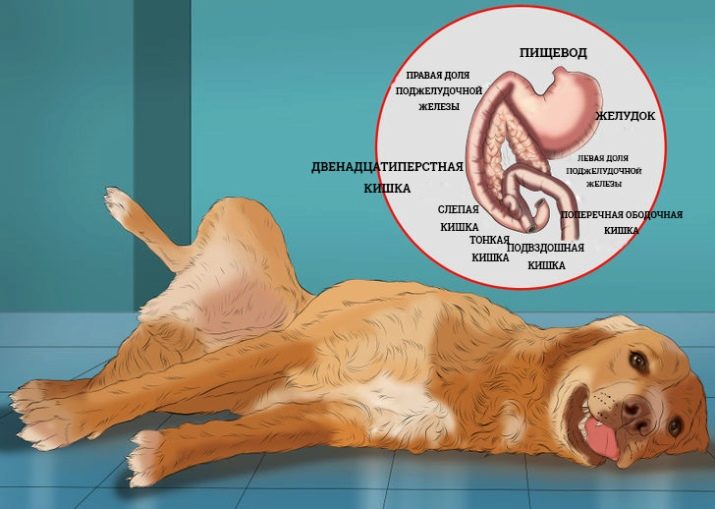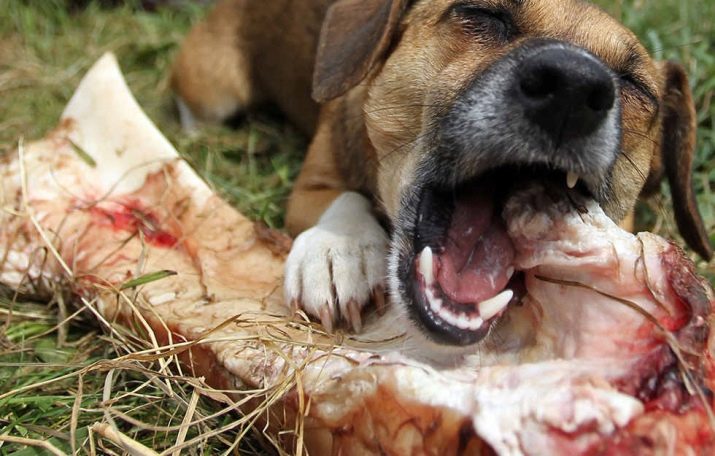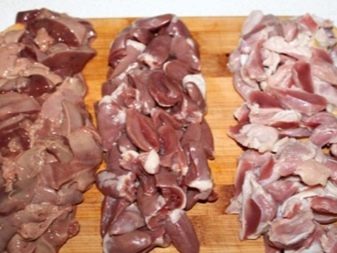At least 70% of the dog's diet should be high in protein sources. In addition to high-quality meat, animals eagerly consume meat by-products - liver, heart, udder, as well as tripe and chicken offal. Despite the rather peculiar appearance and unpleasant aroma, these products have great nutritional value for pets.
Advantages and disadvantages
Everyone knows that the giblets contain much more useful vitamins, micro-and macronutrients, than in muscle meat. They are a complete source of proteins, which are considered the main building material for the organs and tissues of every organism.
Offal is rich in iodine, phosphorus, potassium, as well as zinc, iron and selenium - pets need these substances for growth and development.
It is important that these products contain elevated concentrations of vitamins B, as well as A, E, K, and in the presence of vitamin D they simply have no equal among all other feeds.
This vitamin is one of the most important for all living beings, since its absence leads to reduced body resistance, muscular dystrophy, and even cancer and autoimmune diseases.
As in marine fish, a lot of omega-3 and-6 acids are accumulated in the guts, which are recognized as an invaluable source of useful energy for animal tissues.
Offal is beneficial to all dogs, but they are of particular value for animals living in the northern regions, where there are very few sunny days. Products are recommended for mandatory inclusion in the dog menu in the winter season. At the same time, there are very few carbohydrates in by-products, so they can be safely attributed to dietary products.
A pleasant bonus to such a set of useful properties of the giblets will be their price - heart, lungs, liver, scar and other tripe are much cheaper than ordinary beef or veal. Thus, their inclusion in the diet significantly reduces the costs of the breeder to feed the pet.
However, not all by-products like animals. So, if all dogs like the liver and heart, the scar, kidneys, as well as lungs, spleen and similar products, many dogs simply do not tolerate, even in minimal amounts. Moreover, some have an allergic reaction to them, which is expressed in diarrhea, vomiting, skin irritations on the face and near the ears, in the armpits and on the feet.
The dog begins to itch constantly, hair loss and the appearance of red spots are possible. There is no point in treating food allergies; the only way out when a similar problem arises is to exclude offal from the animal's diet.
In addition, it should be noted that offal will be a good addition to the meat, but not its replacement, so their share in the pet menu should not exceed 15%.
Kinds
The following offal is suitable for feeding animals.
- Liver. This body is considered a natural filter that detains all toxins in food, but does not accumulate them, contrary to popular opinion, but removes it, because it can safely include the diet of your pet. The product is rich in retinol, which is considered a powerful antioxidant that significantly improves the digestive process and has a beneficial effect on the reproductive system of the animal. Beef and pork liver are rich in B vitamins, which contribute to the improvement of nervous activity and blood supply to the brain.
The iron present in the by-product increases hemoglobin, participates in the metabolism and saturation of the cells of all tissues and organs with oxygen. The liver is particularly useful for young dogs and puppies, and should also be included in the diet of bitches during the preparation period for mating and during lactation.
Under the action of elevated temperatures, beneficial trace elements in the liver are partially destroyed, so it is desirable to give the product not boiled, but raw. Keep in mind that sometimes it may contain larvae and helminth eggs, so only a product that has passed veterinary control is subject to inclusion in the pet menu.
- Lung. This organ in structure is a concentrated connective tissue, it contains almost no proteins, and its caloric content is extremely low. No nutritional value is easy for dogs and does not benefit. Most often, the lung is dried and offered to pets for cleaning tartar.
- A heart. This is a by-product, rich in an immunomodulator, coenzyme Q10, which plays a huge role in maintaining cellular immunity, inhibiting age-related changes and rejuvenating the body. The product is rich in zinc, selenium, phosphorus and vitamins of group B. It is also rich in amino acids, which help the animal build muscle, store up the necessary energy and develop physical endurance. The heart contains 1.5-2 times more elastane and collagen than muscle meat, and this is important for the joints and cartilage of dogs. According to the structure of the product, it looks like ordinary meat, but a bit heavier. In the dog's diet, the heart is injected raw.
- Kidney. These by-products contain an increased concentration of vitamins A, E, K and B - these are components that help improve the quality of animal hair, and also participate in the normalization of digestive processes. Before feeding, you need to cut the organ into several parts, soak it in cold water for several hours to destroy the specific smell and give the dog raw.
- Udder It is rich in all the vitamins necessary for the full development of a dog, but it also includes a lot of fat and connective tissue, therefore the portions of the product must be small. It should be noted that the udder is well absorbed by the body of the quadruped, its use contributes to building muscle mass and increase strength.
- Brain. It is a highly digestible food rich in healthy choline and lipids. Brains are especially useful for weakened dogs recovering from a serious illness. Usually they are given boiled with rice or buckwheat.
- Spleen. This by-product is saturated with iron and high-quality protein. According to the concentration of amino acids, the spleen approaches the beef liver. Nevertheless, we should not forget that its excessive consumption leads to digestive disorders and black diarrhea, so its presence in the menu should be minimal.
- Scar. It is a part of the stomach that is especially valuable in terms of the presence of vitamins and enzymes. Inclusion in the menu of such a product helps to improve the digestion of the animal, thanks to enzymes, blood is cleaned from toxins and strengthens the immune system. A scar is nutritious for dogs, but not every animal loves it, since this product has a rather specific smell.
- Ears, tails, legs. There are practically no proteins in the listed products, but there is an excess of phosphorus and potassium, so they are considered to be an excellent trainer for the teeth and jaws of the animal. In addition, there are many tendons that contain collagen, so including them in the diet will benefit the joints of dogs. Most often, they are given to pets raw, but some owners prefer to cook these offal for about 3-4 hours. So it turns out very rich broth, which, as it cools, turns into a trecil jelly.
It can be given to all, without exception, dogs, starting from 4 weeks of age.
- Cartilage products. Kaltyk, as well as the diaphragm, trachea and epiglottic cartilage are distinguished by a high concentration of proteins, elastane and collagen, because they can be entered into the dog's diet without fear.
These products effectively strengthen the teeth and jaws of dogs, and in addition, they are cheap and do not require additional treatment.
Bird giblets
Inexpensive, but at the same time nutritious food for dogs are the heart, liver, and also the necks, paws and heads of birds. They almost do not cause allergic reactions, are rich in collagen (especially a lot of it is accumulated in the wings and necks), as well as protein - it is abundantly contained in chicken legs and heads.
The nutritional value of poultry by-products is not as high as beef, but they can be a quality supplement to the daily diet of the animal. Hearts, liver and stomach are saturated with vitamins A and B, as well as with microelements - zinc, iron. Such offal can be given to dogs no more than 2 times in 7-10 days.
Spongy bones, neck and legs of chickens contain a lot of potassium and phosphorus, because they are indispensable for the formation of the musculoskeletal system. In addition, pets can always benefit from the opportunity to sharpen their teeth about them.
Keep in mind that giving tubular bones to animals is strictly prohibited, since they cannot digest their stomachs, and in the gnawed form they can injure the stomachs of dogs.
It is very useful to dogs minced bone residue, which includes bone tissue, bone marrow and cartilage. It is given in combination with cereals, vegetables and meat.
Delicious and nutritious aspic can be made from chicken legs. After boiling, the broth is cooled, the bones are separated, claws are removed and sent to freeze. Jelly can be offered to dogs as an independent dish, or with cereals.
But chicken skin is not the place in the bowl of your four-legged friend - this part of the carcass contains a lot of harmful cholesterol, because the dog's body does not carry any value.
How to choose?
Dogs can be fed exclusively fresh giblets, which are obtained from healthy animals. It is advisable to purchase products on the market and in stores - that is, in those places where they pass sanitary control.
Offal purchased from hands often contain worms or signs of rotting. Particular danger to dogs are stale brains and spleen. The main point indicating the staleness of the products becomes a creamy consistency, an earthy hue and an unpleasant smell. In addition, the processes of decomposition that have begun can be identified if the fresh-looking spleen begins to darken when cut.
Keep in mind that if your pet suffers from digestive disorders, it is not allowed to include the rumen, spleen, lungs, as well as the kidneys and brains in the menu. In this case, only the use of heart, liver and cartilage products is allowed.
How much can I give?
It is desirable to teach young dogs to giblets from six months, the use of chicken paws and necks is allowed from 2-3 months, and younger children can be fed only with broth or aspic.
The share of offal in the dog's diet should not exceed 15%, while you can give them a little every day, and it is possible to replace meat with offal 1-2 times a week. Full transition to these products is unacceptable due to the low content of proteins in them and excessively high concentrations of vitamins and microelements.
How to store and cook?
After purchase, it is necessary to freeze offal for about 2 weeks to destroy all kinds of pathogenic microflora. If you have any doubts about the freshness of the product - throw it out, as a last resort, you can stand them for about half an hour in a solution of soda, then rinse under cold running water.
Before serving the dog, frozen foods are doused with boiling water and finely chopped. A very good delicacy of by-products can be made by drying them. This can be done in several ways.
- In the dryer. Many housewives have such a gadget in the kitchen as a dryer for meat and fruit. You can buy it at any hardware store. In order to prepare a treat for your dog, it is necessary to freeze the bag with offal in the freezer for about 2 weeks, then defrost naturally, rinse thoroughly, cut into thin pieces and send to the device. It usually takes about 8 hours to prepare a meal.
- In the oven. Prepared meat is placed on a lattice covered with parchment and sent to the oven. Processing is carried out for about 6 hours at a temperature of 60-70 degrees, the door should be opened.
- On the street. The offal is cut into thin layers, strung on a rope and hung in a shady place. However, in this case, you can not avoid the invasion of flies, because it is desirable to close the workpiece with gauze.
About why the dog necessarily needs offal and why it is undesirable to feed them only with clean meat, see below.
